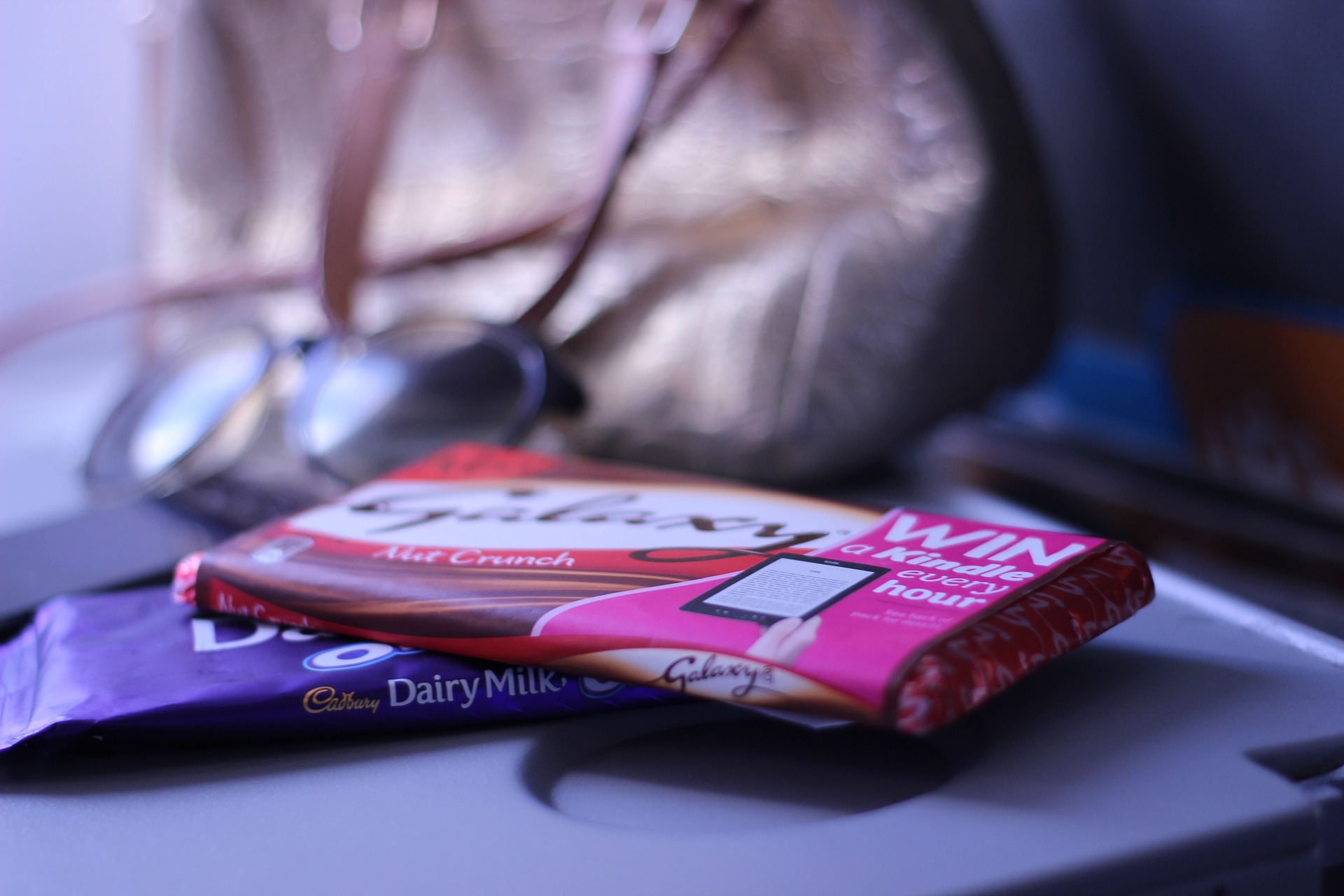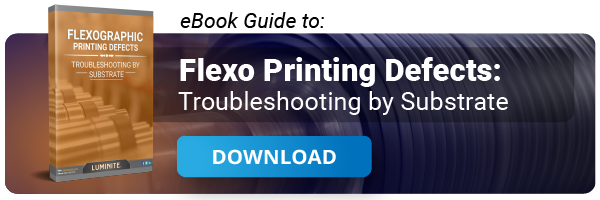Share this
Troubleshooting Flexible Packaging Print Problems
by Luminite on Nov 19, 2019 11:04:54 AM

Flexographic printing is rapidly being adopted for many types of commercial packaging uses, but with each type some challenges may be encountered in the printing process. In this piece we will look at flexible packaging print problems.
The Flexible Packaging Association defines flexible packaging as a package, or part of a package, where the shape can be easily changed. Flexible packaging is useful for items such as bags, stand-up pouches, or liners. The FPA predicts this will be one of the fastest growing segments of the packaging industry.
Flexographic printing can provide high resolution and brilliant graphics on flexible packaging, but there are some elements of the process which must be managed differently for the non-rigid substrates.
Top 5 Culprits: Troubleshooting Problems with Flexo Printing on Flexible Packaging
If you are experiencing issues with flexo printing on flexible packaging, consider the following troubleshooting items:
- Ink
- Ink PH
- Ink Viscosity
- Printing Plates
- Dirt and Contaminants
1. INK:
Inks used for printing flexible packaging must be compatible with the substrate material. Some flexible materials are more heat-tolerant than others, and some are more ink-absorbing.
Ink selection must be adjusted accordingly to account for the substrate qualities.
2. INK PH:
Some print problems can be traced to the ink's pH. The packaging material could consist of anything from film, paper, and aluminum -- to composites such as polyester, polyvinyl chloride, polyethylene, and polypropylene.
Each material requires inks with varying pH levels that dry quickly or slowly, so they adhere to the substrate.
3. INK VISCOSITY:
If your viscosity levels are off, then your flexible packaging print runs might have trouble with abrasion, foaming, spotty ink deposits, smeared ink or uneven appearance, uneven colors, halos, and fisheyes.
4. PRINTING PLATES:
Flexible materials can be much more susceptible to movement during the print process. Different materials may have varying thicknesses which could affect the print quality.
Check the tension on your machines before every print run, and be sure to maintain your sleeves or plates properly.
Dirty, soft, worn, or loose plates can also lead to:
- Dirty prints
- Uneven ink transfer
- Spotty printing
- Streaking
- Washboard effects
- Image bleeding.
5. DIRT AND CONTAMINANTS:
In an industrial setting such as a printing room, machinery in action promotes static electricity. This attracts floating dust, tiny ink particles, and other contaminants which can accumulate on the print elements and substrate.
These contaminants can compromise the quality of the entire print process.
How to Improve Common Flexible Packaging Printing Problems
Challenges in flexible packaging can include poor print quality, improper ink dry time, clean-up problems, and other mishaps. Tips on how to improve the process include:
- Proper Press Maintenance: Always maintain presses properly, monitor printing pressure, and eliminate wobbling by checking bearings, shafts, and gear tip and alignment.
- Appropriate Tension: Adjust the tension to keep the substrate sufficiently tight, especially when starting and stopping.
- Gears: Check the condition, cleaning and lubrication of gears regularly.
- Eliminate Contamination: Keep image carriers in top condition and look for leftover dried ink on the anilox.
- Preserve the Image Carrier: Avoid using harsh solvents or cleaning agents, unless your image carrier has been especially chosen for them.
- Distribution: Choose the appropriate carrier type, whether it be cylinder, sleeve, or plate, to ensure the best transfer to the packaging material.
- Anilox: Choose an anilox with cells that hold ink and support its transfer at the appropriate rate. Cell count, shape, and depth determine the proper volume for the design.
Flexo Problem Still Not Solved?
Flexo printing on flexible packaging requires a delicate balance of several components. For a print run to turn out exactly as expected, all components have to be exactly right.
For more information about troubleshooting your flexible packaging printing problems, contact a flexographic printing expert at Luminite.
Share this
- Flexographic Printing (81)
- Image Carrier (28)
- Elastomer sleeves (27)
- Ink Transfer (25)
- Quality (22)
- Flexo sleeve (20)
- News (18)
- printing defects (18)
- flexo printing defects (17)
- sustainability (13)
- Flexo Troubleshooting (12)
- Ink (12)
- Digital Printing (10)
- Flexo 101 (10)
- Flexo Inks, (9)
- Anilox (7)
- Blister Packaging (7)
- Cost (6)
- print misregistration (6)
- regulations (6)
- Corrugated Printing (4)
- pinholing (4)
- "Tradeshow (3)
- Digital Flexo (3)
- Gravure Printing (3)
- Insider (3)
- Load-N-Lok (3)
- Wide Web (3)
- direct laser engraving (3)
- flexo-equipment-accessories (3)
- gear marks (3)
- halo (3)
- testing (3)
- Narrow Web (2)
- bridging (2)
- feathering (2)
- filling in (2)
- mottled image (2)
- pressure (2)
- Labelexpo (1)
- dirty prints (1)
- doughnuts (1)
- embossing (1)
- kiss impression (1)
- October 2023 (2)
- September 2023 (1)
- August 2023 (1)
- July 2023 (3)
- June 2023 (1)
- May 2023 (5)
- April 2023 (1)
- March 2023 (2)
- February 2023 (1)
- January 2023 (3)
- December 2022 (1)
- October 2022 (3)
- September 2022 (2)
- August 2022 (2)
- July 2022 (3)
- May 2022 (1)
- April 2022 (4)
- March 2022 (2)
- February 2022 (5)
- January 2022 (7)
- December 2021 (1)
- November 2021 (3)
- October 2021 (2)
- September 2021 (1)
- August 2021 (1)
- July 2021 (3)
- June 2021 (1)
- May 2021 (4)
- April 2021 (4)
- March 2021 (4)
- February 2021 (2)
- December 2020 (1)
- November 2020 (1)
- October 2020 (2)
- September 2020 (1)
- August 2020 (3)
- July 2020 (2)
- June 2020 (3)
- May 2020 (1)
- April 2020 (1)
- November 2019 (3)
- October 2019 (1)
- August 2019 (1)
- July 2019 (1)
- April 2019 (1)
- March 2019 (1)
- January 2019 (1)
- October 2018 (2)
- August 2018 (1)
- July 2018 (1)
- June 2018 (1)
- February 2018 (2)
- October 2017 (1)
- September 2017 (2)
- January 2016 (1)
- February 2015 (1)
- January 2015 (1)
- December 2014 (2)
- September 2014 (1)
- February 2014 (1)
- January 2014 (1)
- December 2013 (3)
- October 2013 (1)
- September 2013 (1)
- June 2013 (1)
- January 2013 (1)


Comments (2)